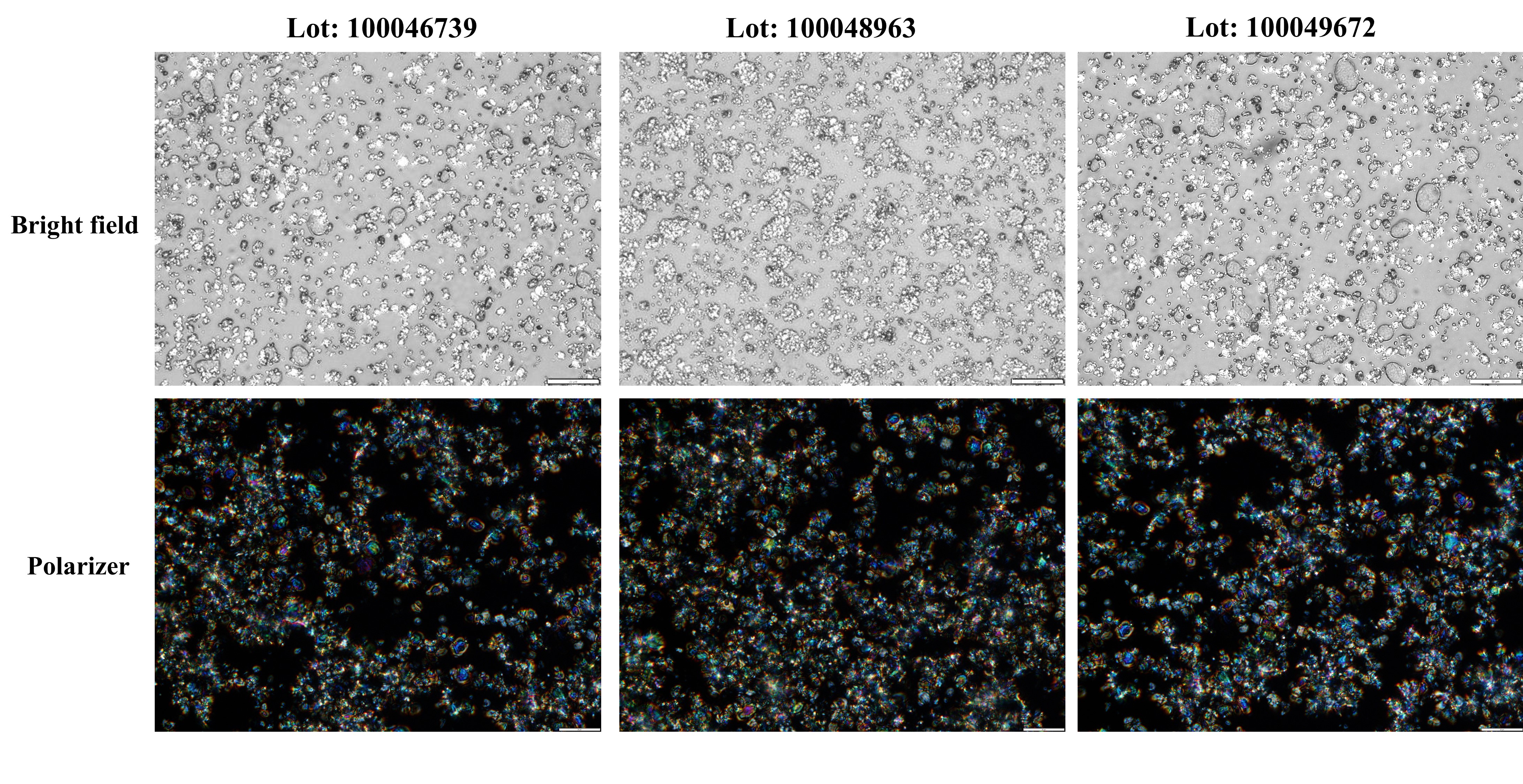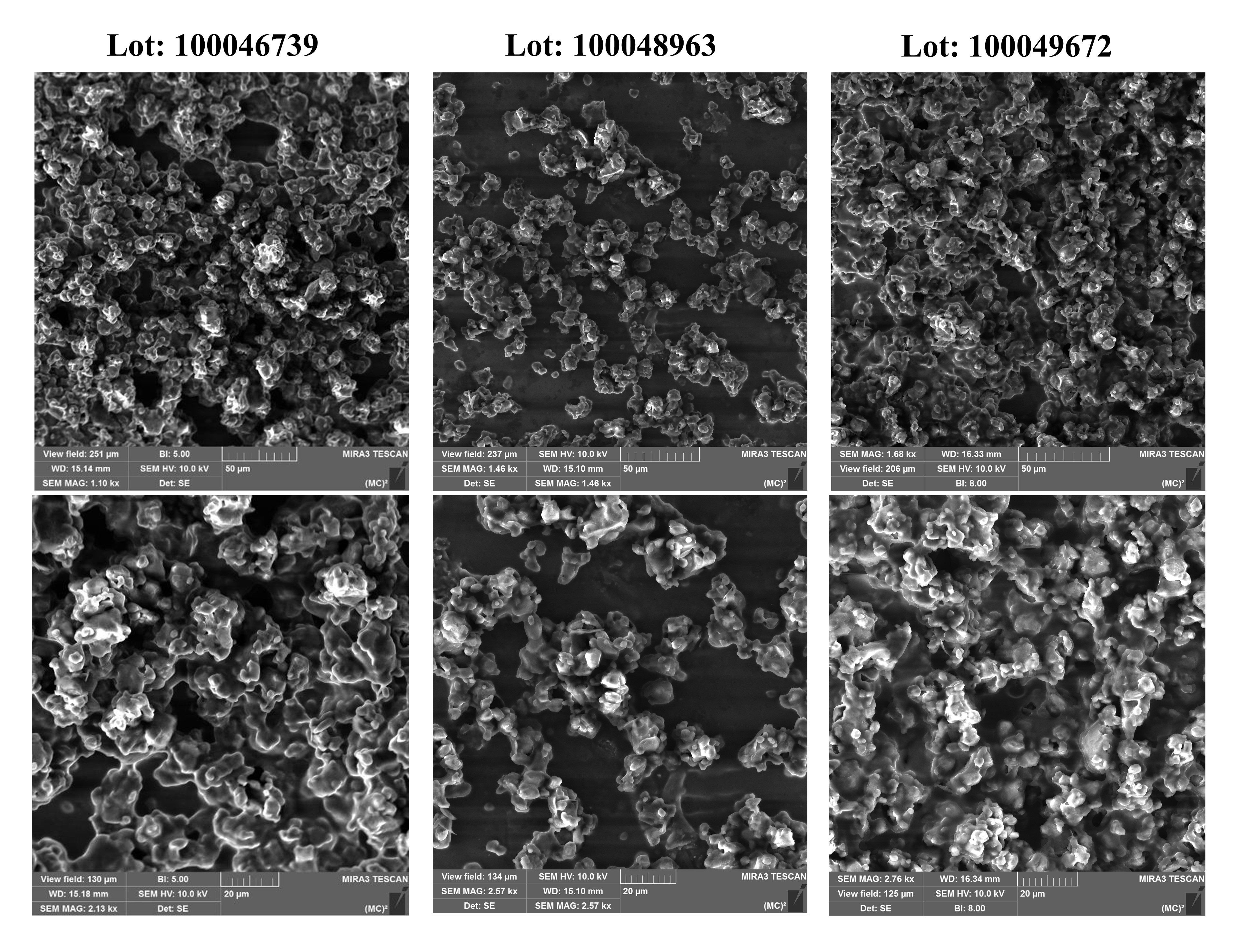Formulation and Delivery - Chemical
Solid-State Characterization of Crinone<sup>®</sup> (Progesterone Vaginal Gel): Microscopy, X-Ray Diffraction, and Thermal Behavior
(T1030-08-52) Solid-State Characterization of Crinone® (Progesterone Vaginal Gel): Microscopy, X-Ray Diffraction, and Thermal Behavior
Tuesday, November 11, 2025
10:30 AM - 11:30 AM CT

Ji Li, PhD (he/him/his)
Dr.
University of Michigan
Ann Arbor, Michigan, United States- KW
Kaikai Wang, MS
Ph.D. candidate
University of Michigan
Ann Arbor, Michigan, United States - YH
Yiran Huo, BS
Master Student
University of Michigan
Ann Arbor, Michigan, United States - VJ
Vivian Juang, MS
Ph.D. candidate
University of Michigan
Ann Arbor, Michigan, United States - AS
Anna Schwendeman, Ph.D.
Larry and Ann Hsu Professor, Professor of Pharmaceutical Sciences
University of Michigan
Ann Arbor, Michigan, United States
Presenting Author(s)
Main Author(s)
Co-Author(s)
Purpose: Crinone® is a clinically established progesterone vaginal gel widely used in hormone replacement therapy and assisted reproductive technology. Despite its long-standing use, the solid-state characteristics of its active pharmaceutical ingredient (API), progesterone, within the gel matrix remain insufficiently understood. This study aims to comprehensively investigate the solid-state characteristics of progesterone in Crinone® by examining crystal morphology, crystalline structure, and thermal properties using polarized light microscopy (PLM), scanning electron microscopy (SEM), X-ray diffraction (XRD), and differential scanning calorimetry (DSC) to support quality control and generic product development.
Methods: Three batches of Crinone® were examined (Lot number: 100046739, 100048963, and 100049672). Crystal morphology was assessed using PLM (Olympus IXplore 71) under polarized light to determine birefringence, indicative of crystallinity. SEM (TESCAN MIRA3 FEGSEM) was employed to visualize the microstructure and distribution of progesterone particles in the gel matrix. A 10 kV voltage and a beam intensity of 8 were used for detection. To confirm crystallinity and identify polymorphic form, powder XRD patterns were recorded using a Rigaku MINIFLEX 600 instrument with a Cu source. The voltage was set at 40 kV and the current was 15 mA. The sample was scanned over a 2θ range from 5° to 40° with a step angle of 0.05° and a scanning speed of 2° /min. DSC (TA Instruments Discovery) was used to evaluate thermal transitions, comparing Crinone® gel to pure progesterone, polymer excipients, and physical mixtures. The heating temperature ranged from 50 to 180 °C, with a heating rate of 10 °C/min under the nitrogen atmosphere.
Results: Under bright field of PLM, progesterone was observed as micron-sized suspensions dispersed within the gel matrix (Figure 1, upper panel). This matrix is formed by cross-linked acrylic acid polymers, including carbomer and polycarbophil. Under polarized light, PLM images revealed strong birefringence across all batches, confirming the presence of crystalline progesterone in the gel (Figure 1, lower panel). These crystal particles exhibited consistent size and morphology, uniformly dispersed throughout the gel matrix. SEM images also corroborated the presence of well-defined, micron-sized progesterone crystals embedded within the polymer network (Figure 2). XRD analysis (Figure 3A) further confirmed crystallinity, with diffraction peaks at 10.55°, 12.70°, 14.55°, 15.35°, and 16.95° corresponding to the known pattern of progesterone Form I. These peaks were consistently observed across all batches, indicating batch-to-batch consistency in crystalline structure. No polymorphic transformation was observed as a result of the formulation or manufacturing process. DSC analysis (Figure 3B) showed a distinct melting peak for pure progesterone around 128 °C, consistent with Form I. The excipients carbomer 934P and polycarbophil exhibited no notable endothermic transitions in the tested temperature range. Physical mixtures of progesterone with polymers preserved the melting peak at 128 °C, indicating no significant solid-state interactions under dry conditions. However, Crinone® gel displayed a broad, shifted thermal event between 100–150 °C rather than a sharp melting peak, suggesting substantial drug-polymer interactions and possible changes in the dispersion state of progesterone within the hydrated gel matrix.
Conclusion: Comprehensive microscopy and XRD characterization demonstrated that progesterone exists in a stable crystalline form within Crinone® and is uniformly distributed in the gel matrix. The crystalline integrity and polymorphic form were preserved during formulation, with consistent physical characteristics across batches. DSC data suggest that while crystallinity is preserved, significant interactions between progesterone and the hydrated gel matrix influence the thermal behavior of the drug. These findings provide critical Q3-level evidence for reverse engineering and bioequivalent generic development of progesterone vaginal gels, as emphasized in FDA regulatory guidance. This study also contributes to a deeper understanding of microstructural attributes in semi-solid vaginal drug delivery systems.
 Figure 1. Microscopic images of three batches of Crinone® under bright field (upper panel) and polarized light (lower panel). The scale bar represents 20 μm.
Figure 1. Microscopic images of three batches of Crinone® under bright field (upper panel) and polarized light (lower panel). The scale bar represents 20 μm.
 Figure 2. SEM images of three batches of Crinone®. The scale bar in the upper panel represents 50 μm and lower panel represents 20 μm.
Figure 2. SEM images of three batches of Crinone®. The scale bar in the upper panel represents 50 μm and lower panel represents 20 μm.
 Figure 3. (A) X-rays diffraction patterns of progesterone (API) and three different batches of Crinone®. (B) Differential scanning calorimetry curves of different ingredients in Crinone® and formulations.
Figure 3. (A) X-rays diffraction patterns of progesterone (API) and three different batches of Crinone®. (B) Differential scanning calorimetry curves of different ingredients in Crinone® and formulations.
Methods: Three batches of Crinone® were examined (Lot number: 100046739, 100048963, and 100049672). Crystal morphology was assessed using PLM (Olympus IXplore 71) under polarized light to determine birefringence, indicative of crystallinity. SEM (TESCAN MIRA3 FEGSEM) was employed to visualize the microstructure and distribution of progesterone particles in the gel matrix. A 10 kV voltage and a beam intensity of 8 were used for detection. To confirm crystallinity and identify polymorphic form, powder XRD patterns were recorded using a Rigaku MINIFLEX 600 instrument with a Cu source. The voltage was set at 40 kV and the current was 15 mA. The sample was scanned over a 2θ range from 5° to 40° with a step angle of 0.05° and a scanning speed of 2° /min. DSC (TA Instruments Discovery) was used to evaluate thermal transitions, comparing Crinone® gel to pure progesterone, polymer excipients, and physical mixtures. The heating temperature ranged from 50 to 180 °C, with a heating rate of 10 °C/min under the nitrogen atmosphere.
Results: Under bright field of PLM, progesterone was observed as micron-sized suspensions dispersed within the gel matrix (Figure 1, upper panel). This matrix is formed by cross-linked acrylic acid polymers, including carbomer and polycarbophil. Under polarized light, PLM images revealed strong birefringence across all batches, confirming the presence of crystalline progesterone in the gel (Figure 1, lower panel). These crystal particles exhibited consistent size and morphology, uniformly dispersed throughout the gel matrix. SEM images also corroborated the presence of well-defined, micron-sized progesterone crystals embedded within the polymer network (Figure 2). XRD analysis (Figure 3A) further confirmed crystallinity, with diffraction peaks at 10.55°, 12.70°, 14.55°, 15.35°, and 16.95° corresponding to the known pattern of progesterone Form I. These peaks were consistently observed across all batches, indicating batch-to-batch consistency in crystalline structure. No polymorphic transformation was observed as a result of the formulation or manufacturing process. DSC analysis (Figure 3B) showed a distinct melting peak for pure progesterone around 128 °C, consistent with Form I. The excipients carbomer 934P and polycarbophil exhibited no notable endothermic transitions in the tested temperature range. Physical mixtures of progesterone with polymers preserved the melting peak at 128 °C, indicating no significant solid-state interactions under dry conditions. However, Crinone® gel displayed a broad, shifted thermal event between 100–150 °C rather than a sharp melting peak, suggesting substantial drug-polymer interactions and possible changes in the dispersion state of progesterone within the hydrated gel matrix.
Conclusion: Comprehensive microscopy and XRD characterization demonstrated that progesterone exists in a stable crystalline form within Crinone® and is uniformly distributed in the gel matrix. The crystalline integrity and polymorphic form were preserved during formulation, with consistent physical characteristics across batches. DSC data suggest that while crystallinity is preserved, significant interactions between progesterone and the hydrated gel matrix influence the thermal behavior of the drug. These findings provide critical Q3-level evidence for reverse engineering and bioequivalent generic development of progesterone vaginal gels, as emphasized in FDA regulatory guidance. This study also contributes to a deeper understanding of microstructural attributes in semi-solid vaginal drug delivery systems.
 Figure 1. Microscopic images of three batches of Crinone® under bright field (upper panel) and polarized light (lower panel). The scale bar represents 20 μm.
Figure 1. Microscopic images of three batches of Crinone® under bright field (upper panel) and polarized light (lower panel). The scale bar represents 20 μm. Figure 2. SEM images of three batches of Crinone®. The scale bar in the upper panel represents 50 μm and lower panel represents 20 μm.
Figure 2. SEM images of three batches of Crinone®. The scale bar in the upper panel represents 50 μm and lower panel represents 20 μm. Figure 3. (A) X-rays diffraction patterns of progesterone (API) and three different batches of Crinone®. (B) Differential scanning calorimetry curves of different ingredients in Crinone® and formulations.
Figure 3. (A) X-rays diffraction patterns of progesterone (API) and three different batches of Crinone®. (B) Differential scanning calorimetry curves of different ingredients in Crinone® and formulations.